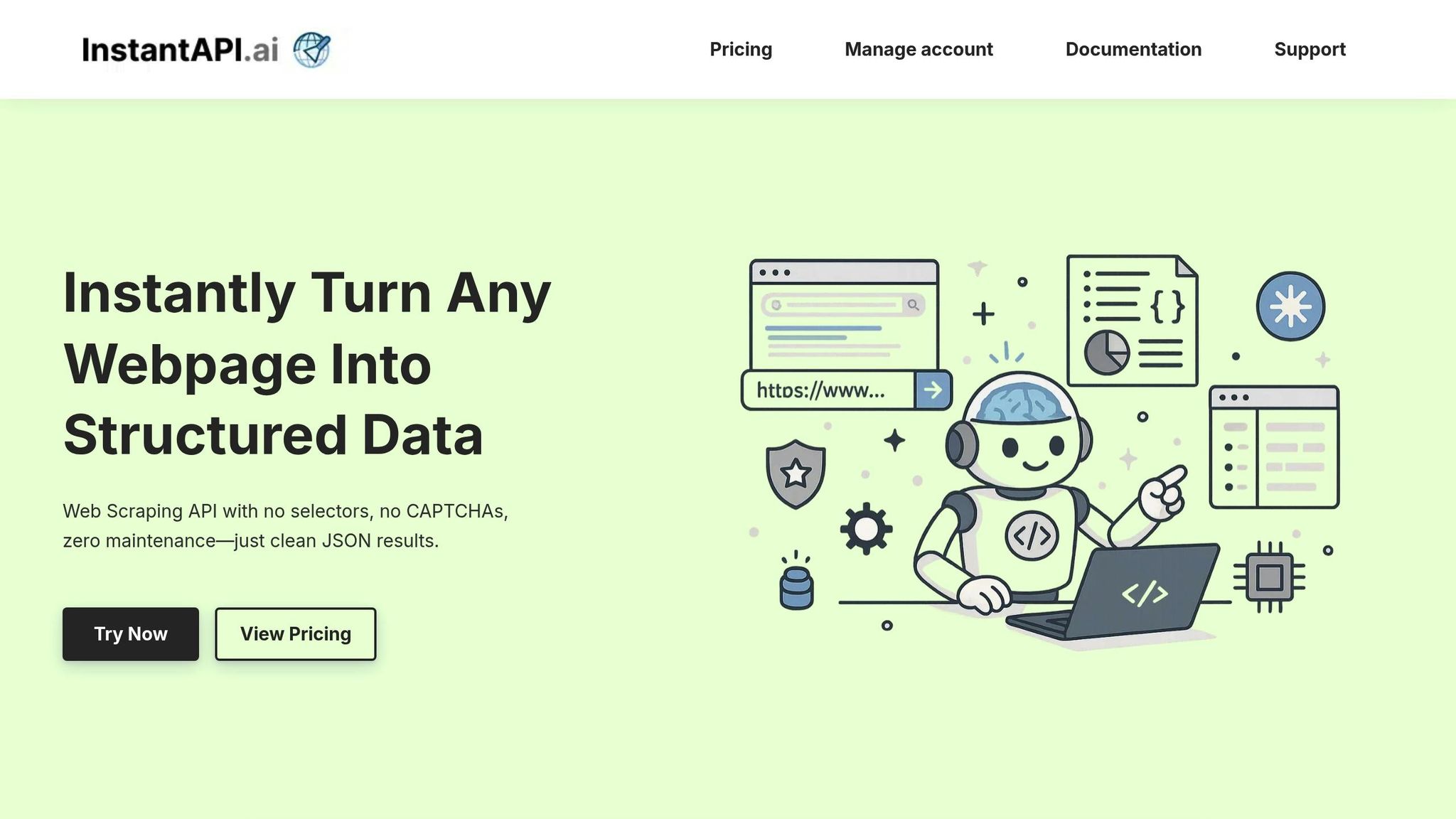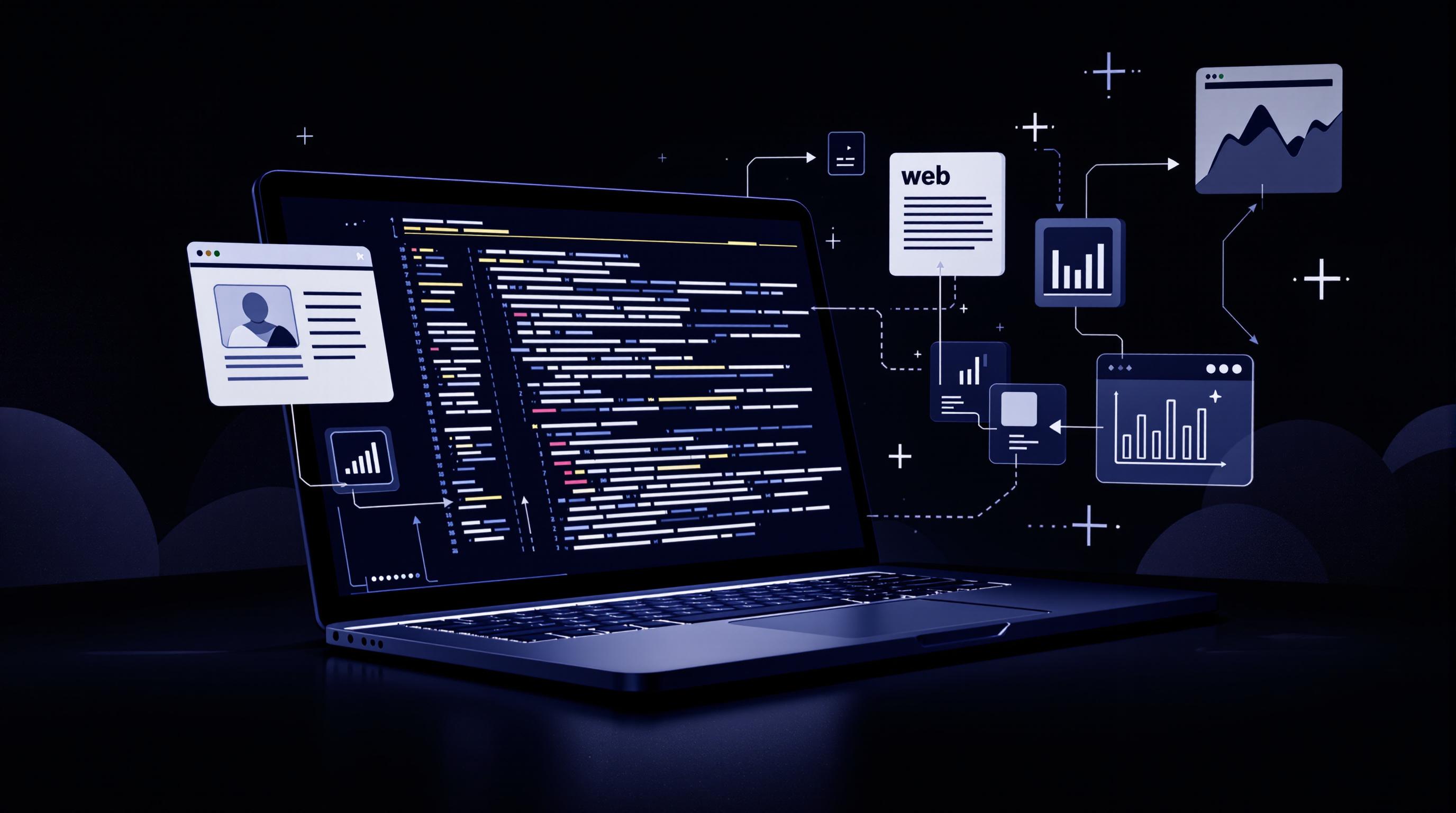Web scraping is transforming transportation by improving route optimization, cutting costs, and enhancing efficiency. Here's how it works and why it matters:
- What Is Web Scraping? It's the automated collection of data from websites, like traffic updates, weather reports, and transit schedules.
- Why It Matters: Route optimization reduces fuel costs by up to 20% and improves delivery times, meeting customer expectations for real-time updates.
- How It Helps: Scraped data provides live traffic conditions, weather forecasts, and competitor insights, enabling smarter, faster decision-making.
- Key Tools: Platforms like InstantAPI.ai make scraping affordable ($2 per 1,000 pages) and accessible, even for small businesses.
- Challenges Solved: Anti-blocking techniques (e.g., proxy rotation) ensure uninterrupted data collection for reliable results.
Bottom Line: Web scraping empowers transportation companies to save money, improve customer satisfaction, and scale operations efficiently. Want to know how it works in detail? Keep reading.
I solved the Delivery / Pickup Route Optimization Problem! 🚚 Free Workbook with Algorithm
Real-Time Data Collection for Route Optimization
Web scraping is a game-changer for transportation companies, offering a way to gather up-to-the-minute data from various sources at once. By pulling information from traffic systems, weather reports, and transit authorities, companies can piece together a detailed view of current conditions. This allows dispatchers to make quick adjustments, ensuring vehicles stay on the move. Let’s break down how specific types of data improve routing accuracy.
Traffic Conditions and Patterns
Traffic data is the backbone of efficient route planning. Up-to-date information enables transportation companies to make dynamic adjustments, avoiding delays and keeping operations smooth. Tools like InstantAPI.ai can scrape data from traffic APIs, municipal websites, and navigation platforms to track congestion, accidents, and road closures in real time.
The financial stakes are high. Traffic congestion costs the U.S. economy about $305 billion annually in lost time and fuel. By leveraging live traffic data, companies can sidestep many of these costs, rerouting vehicles to avoid gridlock.
Traffic management systems provide a wealth of real-time details, including current speeds, accident reports, construction updates, and road closures. This information, often refreshed every few minutes, allows dispatchers to stay ahead of potential problems. Historical traffic data also plays a role, helping companies predict peak congestion times and plan accordingly.
Studies show that 34.26% of routes can be improved by finding shorter alternatives throughout the day. This statistic underscores how dynamic traffic conditions create constant opportunities for better routing when real-time data is available.
Weather Updates and Road Conditions
Weather can make or break a day in transportation, which is why having real-time weather data is so critical. Web scraping enables companies to gather detailed weather insights from sources like the National Oceanic and Atmospheric Administration (NOAA) and state Departments of Transportation (DOTs).
"Weather impacts nearly every aspect of our daily lives, and for businesses, it's no different. What makes weather data especially powerful is its versatility. From optimizing marketing campaigns based on seasonal shifts to enhancing precision in agriculture, the applications span industries." - Sandro Shubladze, CEO and Founder, Datamam
Transportation companies can scrape data on temperature, humidity, wind, visibility, atmospheric pressure, UV index, cloud cover, precipitation forecasts, and severe weather alerts. This information helps dispatchers anticipate weather-related challenges, ensuring safer and more efficient operations.
Road condition data from state DOTs provides additional insights, such as ice warnings, snow removal updates, flooding alerts, and visibility concerns. By combining this with live weather forecasts, companies can reroute vehicles to avoid hazardous conditions before issues arise.
For instance, one transportation company used scraped weather data to preemptively adjust routes during severe storms, cutting delays by 15%.
Transit Schedules and Intermodal Coordination
While weather and traffic data improve road efficiency, aligning transit schedules adds another layer of precision. Modern transportation often involves coordinating multiple modes of travel, like buses, trains, and rideshares. Web scraping allows companies to pull schedule data from various sources, streamlining this process.
The General Transit Feed Specification (GTFS) is a widely used format for public transit schedules and geographic data. As of December 2019, OpenMobilityData lists 1,233 providers offering GTFS feeds, with 465 in the United States. This standardized format simplifies coordination between different services.
GTFS data includes fixed-route schedules, route details, bus stop locations, fare information, and real-time arrival updates. By scraping this data, transportation companies can synchronize their services with public transit systems, creating seamless connections for passengers.
"We chose CSV as the basis for the specification because it's easy to view and edit using spreadsheet programs and text editors, which is helpful for smaller agencies. It's also straightforward to generate from most programming languages and databases, which is good for publishers of larger feeds." - Joe Hughes, Google Transit Team Member
The standardized nature of GTFS data means that applications designed for one city can easily be adapted for others. This makes it easier for companies to scale their operations while maintaining smooth coordination with local transit systems.
Scraped transit data can be used for trip planning, mobile apps, timetable creation, and operational analysis. When paired with real-time updates, this data ensures passengers get accurate arrival times and better travel options.
Technologies and Tools for Web Scraping in Transportation
For transportation companies, having the right tools for web scraping can be the difference between smooth operations and data chaos. With traffic patterns and weather conditions changing constantly, reliable data extraction technology is essential for keeping things running efficiently. Let’s break down the tools, AI integration, and anti-blocking strategies that make web scraping work seamlessly in this industry.
Overview of Web Scraping Tools
When it comes to transportation services, choosing the right web scraping tool is all about matching it to your specific data needs. InstantAPI.ai is a standout option, offering a simple, pay-as-you-go model. At $2 for every 1,000 web pages scraped and no minimum spend, it’s a budget-friendly solution for companies looking to collect real-time data without committing to large-scale investments. Its straightforward interface and scalable pricing make it a go-to for transportation businesses aiming to stay agile.
Data Integration with AI for Route Planning
Web scraping becomes even more impactful when paired with AI. By feeding scraped data into AI algorithms, transportation companies can optimize routes in ways that save time and money. This combination turns raw traffic and weather data into actionable insights, helping businesses make smarter routing decisions.
Take Amazon, DHL, and Maersk as examples. These companies have used AI alongside web scraping to cut costs, improve delivery times, and reduce fuel usage and emissions. With fuel making up 30–40% of fleet operating expenses, these savings are no small matter. The U.S. fleet management market alone is expected to hit $52.5 billion by 2030, and AI-driven route optimization is poised to play a big role in that growth.
Anti-Blocking Techniques for Reliable Data Extraction
Consistent data access is critical for transportation companies, but many websites employ measures to block automated scraping. That’s where anti-blocking strategies come in, ensuring uninterrupted data flow.
One key method is premium proxy rotation, which uses residential IP addresses that rotate automatically. This spreads out requests across various locations, making them harder to detect. Another tactic is request randomization, which introduces delays (usually 45–75 seconds) between requests to mimic human browsing behavior. Techniques like header spoofing and user agent rotation further disguise scrapers as regular browsers by cycling through updated browser configurations.
Here’s a quick look at anti-blocking challenges and how to tackle them:
| Anti-Blocking Challenge | Solution Approach | Priority |
|---|---|---|
| IP address blocking | Premium proxy rotation with residential IPs | High |
| Rate limiting detection | Randomized request timing and delays | High |
| Browser fingerprinting | User agent rotation and header spoofing | Medium |
| CAPTCHA challenges | Automated solving or API bypass | Medium |
| Honeypot traps | Link filtering and pattern recognition | Low |
Modern web scraping APIs simplify this process by automatically handling complex challenges like CAPTCHA bypassing. This lets transportation companies focus on analyzing the data rather than worrying about the technical hurdles of scraping. Additionally, robust monitoring systems and fallback mechanisms ensure that even as websites update their defenses, data collection remains steady and reliable.
sbb-itb-f2fbbd7
Key Benefits of Web Scraping for Transportation Services
Transportation companies are leveraging web scraping to boost efficiency and improve customer satisfaction. By gathering real-time data, businesses can optimize routes, cut fuel costs, and reduce delays. Let’s dive into how web scraping is transforming operational performance, enhancing customer experiences, and supporting growth in transportation networks.
Improved Efficiency and Cost Savings
Real-time transportation management systems (TMS) can cut freight costs by 8–10% and reduce invoice discrepancies by as much as 80%. GPS tracking paired with route optimization has the potential to lower fuel expenses by up to 15%. Imagine the impact: a 15% reduction in fuel costs can free up substantial resources for reinvestment in advanced routing technologies. This creates a cycle of continuous improvement in operational efficiency.
Take Maersk, for example. In 2024, this global shipping giant used real-time data to monitor shipments, minimize delays, and enhance overall efficiency. Similarly, Unilever optimized its European supply chain with real-time insights, ensuring timely deliveries and fewer disruptions.
Enhanced Customer Experience
Web scraping allows transportation companies to provide customers with accurate, real-time updates. By analyzing live data on traffic, weather, and delivery schedules, businesses can offer precise delivery windows and notify customers proactively about possible delays. In 2024, Zalando, a top European online fashion retailer, showcased this approach. By monitoring shipments and analyzing data, they reduced delays and kept customers informed throughout the delivery process.
Retailers, particularly during peak shopping seasons, use web scraping to track carrier performance and anticipate delays. This enables them to adjust shipping plans and ensure products are delivered on time, keeping shelves stocked and customers happy. Additionally, monitoring online reviews and feedback helps companies identify service gaps and refine their operations to meet growing customer expectations.
Scalable Solutions for Expanding Transportation Networks
As transportation networks grow, so does the volume of data they must handle. Web scraping provides a scalable way to manage this influx without compromising performance. The web scraping market is expected to reach $2.45 billion by 2036, with an annual growth rate of over 13%, underscoring its importance.
A great example of scalability comes from a public transportation company that switched to the webRobots platform. By automating data collection, they moved away from manual aggregation, enabling them to manage diverse data sources more efficiently. Modern web scraping tools support both vertical and horizontal scaling, ensuring that data collection keeps pace with expanding operations.
Investing in reliable web scraping tools that can handle large data volumes and frequent updates is key. With the right infrastructure, transportation companies can ensure consistent data quality as they grow into new markets and service areas.
The Future of Route Optimization with Web Scraping
Transportation companies are increasingly using AI-powered web scraping to refine route planning. By combining artificial intelligence and machine learning, web scraping is reshaping how routes are planned and managed. As these technologies continue to advance, transportation services are poised to see even more transformative changes in their operations.
Key Takeaways
Here are some key benefits of these advancements:
- Cost Savings: AI-optimized routes help cut costs by improving fuel efficiency and streamlining operations.
- Scalability: These solutions can grow alongside expanding operations without sacrificing performance or data quality.
- Improved Customer Experience: Real-time data analysis ensures accurate delivery windows and timely updates for customers.
- Automation: Automated data collection eliminates manual work, supporting growth as networks expand both vertically and horizontally.
The Role of InstantAPI.ai in Transportation Innovation

At the core of these routing improvements lies efficient data extraction, and InstantAPI.ai is leading the way. Offering a cost-effective and real-time data extraction solution, InstantAPI.ai charges just $2 per 1,000 web pages scraped. This pay-as-you-go model eliminates the need for minimum spending or heavy infrastructure investments, making it accessible to businesses of all sizes.
The platform’s API simplifies tasks like scraping data, extracting links, managing pagination, and processing search results. This ease of use allows companies to adopt web scraping for route optimization without requiring advanced technical expertise or significant upfront costs.
Looking Ahead: Trends in Transportation Technology
Emerging technologies are set to further revolutionize transportation. AI-driven urban mobility is expected to enhance traffic flow, boost safety, and predict transportation demand with remarkable precision. The global AI market in logistics and transportation is forecasted to grow from $2.1 billion in 2024 to nearly $6.5 billion by 2031, with an annual growth rate exceeding 17%.
"Technology alone cannot solve urban mobility challenges; policy plays a critical role."
– Regina Clewlow
Digital twins are becoming a crucial tool for city planning, enabling virtual simulations of transportation networks to test policies before implementation. Meanwhile, the rapid adoption of electric vehicles is creating a need for data platforms that can manage charging demand and station availability.
Autonomous freight and delivery systems are also reshaping last-mile logistics. Pilot programs have shown a reduction in accidents by up to 40%. These systems rely heavily on real-time data, making web scraping an indispensable tool.
Machine learning algorithms are leveraging scraped data to identify trends, optimize pricing, and improve scheduling. This paves the way for hyper-personalized transportation services, where AI-driven analytics predict travel demand and adjust operations dynamically.
Additionally, the rise of Data-as-a-Service (DaaS) models is changing how transportation companies access and utilize data. Instead of building internal scraping tools, businesses can now subscribe to real-time, structured insights. These insights cover everything from compliance management to scalable data handling and AI-powered analytics.
As these trends evolve, web scraping will remain a cornerstone of transportation innovation. It provides the real-time data needed to power smarter, more efficient, and sustainable systems, driving precise route optimization and operational success.
FAQs
How do transportation companies use web scraping to optimize their routes?
Transportation companies rely on web scraping to gather real-time information like traffic updates, weather conditions, and transit schedules. This data allows them to adjust routes on the fly, helping to avoid delays, cut down on fuel usage, and speed up delivery times.
For instance, by analyzing live traffic flows and weather forecasts, companies can pinpoint the quickest and most efficient routes. Web scraping automates the data collection process, saving both time and resources while improving overall operations. The result? Lower costs and happier customers, thanks to more reliable service and on-time deliveries.
What challenges do transportation companies face with web scraping for route optimization, and how can they address them?
Transportation companies encounter several hurdles when using web scraping to optimize routes. These challenges include navigating anti-scraping defenses like CAPTCHAs and IP bans, adjusting to frequent website changes that can disrupt scraping scripts, and scaling their scraping systems to handle increasing demands. On top of that, ensuring adherence to legal and ethical standards adds another layer of complexity.
To tackle these obstacles, companies can implement strategies such as using premium proxies to avoid detection, employing headless browsers to simulate human browsing behavior, and automating script updates to adapt to website changes. Web scraping APIs can also be a game-changer, simplifying the process by addressing common roadblocks and improving efficiency. Staying compliant with regulations and closely monitoring websites for updates are key to maintaining long-term success.
How can small transportation businesses use tools like InstantAPI.ai to improve route planning and stay competitive?
Small transportation businesses can tap into tools like InstantAPI.ai to access real-time data on traffic conditions, weather updates, and transit schedules. This information helps them plan routes more efficiently, make quicker decisions, and minimize delays. The result? Lower operating costs and happier customers.
On top of that, web scraping offers a way to track industry trends and keep an eye on competitor pricing. These insights let businesses fine-tune their strategies to stay ahead in the market. Pairing these tools with AI takes things a step further by automating data analysis, simplifying operations, and boosting service efficiency. This combination levels the playing field, enabling smaller companies to compete with larger ones by offering dependable and affordable transportation services.


